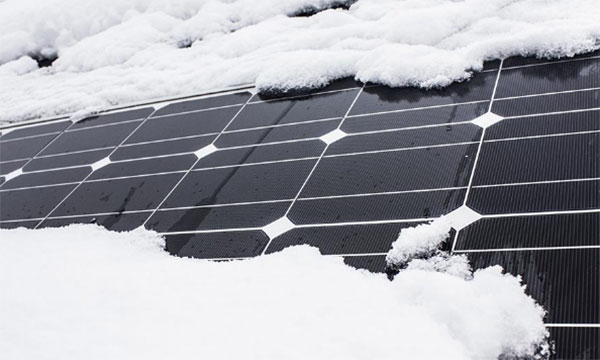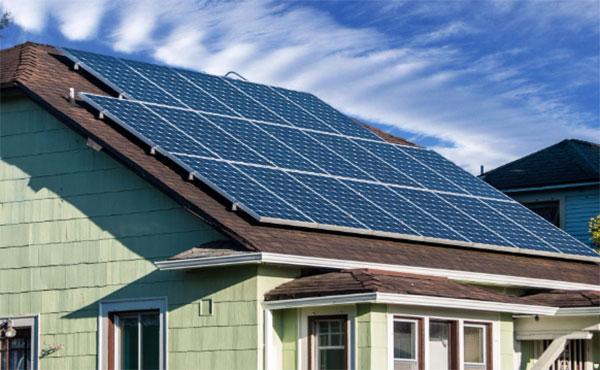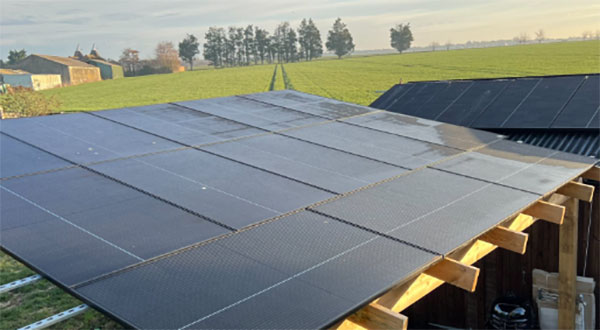Description
Yes, lightning can damage solar panels, affecting both their physical structure and electrical components, necessitating repairs or replacements.

Understanding Solar Panels and Lightning
How Solar Panels Work
Solar panels, or photovoltaic (PV) panels, convert sunlight into electricity using semiconducting materials such as silicon. Each panel consists of many solar cells connected together. When sunlight hits a solar cell, it generates an electric current by exciting electrons in the silicon.
This process is known as the photovoltaic effect.
The efficiency of solar panels, which is a measure of their ability to convert sunlight into electricity, typically ranges between
15% and 22%. The power output of a standard residential solar panel is around
250 to 400 watts, with larger panels for commercial use capable of producing up to
400 to 600 watts. The cost of solar panels can vary widely, with a residential solar panel system averaging between
$15,000 and $25,000 after tax credits, depending on the system's size and complexity.
Solar panels have a lifespan of about
25 to 30 years, after which their efficiency gradually decreases. The material quality, such as the purity of the silicon used, plays a significant role in the panel's efficiency and lifespan.
The Nature of Lightning and Its Impact
Lightning is a natural electrical discharge of very short duration and high voltage between a cloud and the ground or within a cloud. Lightning strikes can cause significant damage to electrical equipment and structures due to the immense energy released, which can exceed
300 million volts and 30,000 amperes.
When lightning strikes a solar panel system, it can cause physical damage to the panels and affect the electrical components of the system, such as inverters and controllers. The impact of lightning is not just limited to direct strikes; indirect effects such as electrical surges can also compromise the integrity of solar panel systems.
To protect solar installations from lightning, specific measures are implemented, including
surge protection devices, grounding systems, and lightning rods. These protective measures aim to divert the lightning's energy away from the solar panels and into the ground, thereby minimizing damage.
The installation of lightning protection can add to the initial cost of the solar panel system but is essential for safeguarding the investment. The additional cost for a comprehensive lightning protection system can range from
$500 to $2,000, depending on the system's size and the complexity of the installation.
Solar panels bring the promise of renewable energy, but they must be adequately protected against the forces of nature such as lightning. By understanding both how solar panels work and the nature of lightning, homeowners and businesses can take informed steps to mitigate risks and ensure the longevity and efficiency of their solar energy systems.

Risks of Lightning to Solar Panel Systems
Direct Strikes vs. Indirect Effects
Direct strikes occur when lightning directly hits the solar panel system. This event can release energy levels exceeding
300 million volts, causing immediate and severe damage to both the physical structure of the panels and the internal electrical components. The aftermath of a direct strike often includes shattered glass surfaces, burnt electrical circuits, and compromised panel integrity, leading to significant repair or replacement costs that can range from
$5,000 to $20,000 depending on the system's scale and the extent of the damage.
Indirect effects of lightning, such as electromagnetic pulses and electrical surges, can also adversely affect solar panel systems. These surges can travel through wiring and damage electronic components like inverters and charge controllers, potentially reducing the system's overall efficiency and lifespan. The cost of replacing these components can vary, with inverters costing between
$1,000 and $2,500 and charge controllers around
$150 to $800. Installing surge protection devices is crucial to mitigate these risks, adding approximately
$200 to $500 to the installation cost.
Components Most Vulnerable to Damage
- Solar Panels: The panels themselves are vulnerable to direct lightning strikes, which can crack or shatter the glass surface, leading to a loss in efficiency or total failure. The cost of replacing a solar panel can range from $250 to $600 per panel, depending on the size and efficiency rating.
- Inverters: Inverters convert DC electricity generated by the panels into AC electricity for home use. They are susceptible to damage from electrical surges caused by nearby lightning strikes. High-quality inverters cost between $1,000 and $2,500, representing a significant portion of the system's total expense.
- Charge Controllers: Charge controllers regulate the voltage and current coming from the panels to the battery. They are crucial for systems with energy storage and can be damaged by indirect lightning effects. The replacement cost for charge controllers ranges from $150 to $800.
- Wiring and Electrical Components: Wiring, connectors, and other electrical components can suffer from both direct and indirect lightning effects, leading to system inefficiencies or failure. The cost of repairing or replacing these components can add several hundred dollars to the maintenance budget.

Assessing Lightning Damage to Solar Panels
Assessing and addressing lightning damage promptly can save significant costs and downtime in solar panel systems. This section outlines how to identify signs of lightning damage and the critical role of diagnostics and inspections in maintaining system health and efficiency.
Identifying Signs of Lightning Damage
Lightning damage to solar panels can range from obvious physical damage to subtle electrical issues. Here are key indicators:
- Physical Damage:
- Cracked or shattered glass on solar panels.
- Burn marks or melted components on or around the solar panels and mounting system.
- Damaged or burnt-out wires and connectors.
- Electrical and Performance Issues:
- A sudden drop in power output, which can indicate damaged solar cells or connections.
- Inverter failure, often shown by error codes or a complete lack of activity, suggesting it has been damaged by a power surge.
- Erratic behavior of the charge controller, including failure to regulate charge properly, can be a sign of electrical damage.
Costs associated with repairing or replacing components due to lightning damage can significantly impact the overall budget. For example, replacing a single solar panel can cost
$250 to $600, while a new inverter may range from
$1,000 to $2,500. Electrical repairs, including wiring and connectors, could add
$200 to $1,000 more to the repair bill.
The Role of Diagnostics and Inspections
Regular diagnostics and inspections play a pivotal role in identifying potential or existing damage early on, thereby mitigating further loss and ensuring the longevity of the solar panel system.
- Visual Inspections: Conducted periodically to check for physical signs of damage or degradation. This process can help identify issues early, before they escalate into major system failures.
- Performance Monitoring: Using system data to track the efficiency and output of solar panels. A significant or unexplained drop in performance can be an early indicator of damage or malfunction.
- Electrical Testing: Includes testing of individual panels, inverters, and other components for functionality and performance. This might involve:
- Voltage and current measurements to ensure panels operate within expected parameters.
- Inverter diagnostics to check for efficient conversion from DC to AC power.
Advantages of regular diagnostics and inspections include:
- Early detection of damage or inefficiencies, potentially saving thousands in repair costs.
- Extending the lifespan of the solar panel system by addressing issues promptly.
- Maintaining optimal system performance, ensuring the highest possible return on investment.
Materials and Quality: Using high-quality materials for repairs or replacements is crucial for maintaining the system's integrity. Opting for components from reputable manufacturers can prevent future failures and ensure the system operates at peak efficiency.

Protection Strategies for Solar Panels Against Lightning
Implementing effective lightning protection strategies is essential for safeguarding solar panel installations. These strategies minimize the risk of damage from direct strikes and secondary effects, ensuring the longevity and efficiency of the solar power system.
Lightning Rods and Their Effectiveness
Lightning rods, or air terminals, provide a direct path for lightning to follow, safely grounding the electrical discharge away from the solar panels and related components.
- Installation: Placement is critical, with rods installed at the highest points of structures to attract lightning.
- Effectiveness: Lightning rods significantly reduce the risk of a direct strike damaging the system. They do not prevent lightning but redirect it, minimizing potential damage.
- Cost: The average cost for a residential lightning rod system ranges from $2,000 to $4,000, depending on the complexity of the installation and the size of the area protected.
Surge Protection Devices
Surge protection devices (SPDs) are critical for protecting the electrical components of a solar panel system from surge voltages caused by indirect lightning strikes.
- Function: SPDs limit the voltage supplied to an electric device by blocking or shorting to ground any unwanted voltages above a safe threshold.
- Installation: Installing SPDs at both the inverter and the electrical service panel is recommended for comprehensive protection.
- Cost and Specs: Prices for quality SPDs range from $50 to $500. Choosing devices with a clamping voltage that matches the system's requirements is crucial for effectiveness.
Grounding Systems for Solar Panel Installations
A proper grounding system is essential for dispersing the electrical energy from lightning strikes, thereby protecting the solar panel installation.
- Components: Includes ground rods, grounding conductors, and grounding electrodes.
- Standards: Following national and local electrical codes for grounding practices ensures the safety and effectiveness of the grounding system.
- Cost: The cost for installing a grounding system varies, typically ranging from $100 to $500, depending on the system's size and the grounding requirements.

Mitigation and Response After Lightning Strikes
When lightning strikes a solar panel system, the aftermath can range from minor to severe damage. Understanding the immediate steps to assess and limit damage, how to repair the system, and the role of insurance and warranties is crucial for system owners.
Immediate Steps to Assess and Limit Damage
- Safety First: Ensure the area is safe before inspecting the system. Turn off the solar system's power supply to prevent electrical hazards.
- Visual Inspection: Look for obvious signs of damage, such as burnt components, cracked panels, or exposed wires.
- Document Damage: Take photos and make notes of any damage for insurance claims or warranty purposes.
- Contact a Professional: Seek a qualified technician to conduct a thorough inspection and assessment. They can identify less obvious damages and recommend the best course of action.
Repairing Lightning-Damaged Solar Panels
- Evaluation: A professional can determine whether panels can be repaired or need to be replaced. The cost of repair can vary widely, from a few hundred dollars for minor issues to thousands for more extensive damage.
- Replacement Parts: Use high-quality materials for repairs to ensure longevity. The cost for new panels ranges from $250 to $600 each, while inverters may cost between $1,000 and $2,500.
- Labor Costs: Depending on the extent of the damage, labor costs for repairs can add $500 to $2,000 to the overall expenses.
Insurance and Warranty Considerations for Lightning Damage
- Insurance Coverage: Most homeowner insurance policies cover lightning strikes, but it's essential to verify the extent of the coverage. The average cost for solar panel insurance varies, but it typically adds a minimal amount to the annual premium.
- Manufacturer's Warranty: Solar panels usually come with a 25 to 30-year warranty, covering defects and sometimes performance. Inverter warranties range from 5 to 10 years. Ensure lightning damage is covered under these warranties.
- Claim Process: Promptly file a claim with detailed documentation of the damage. Delays can affect coverage eligibility.








